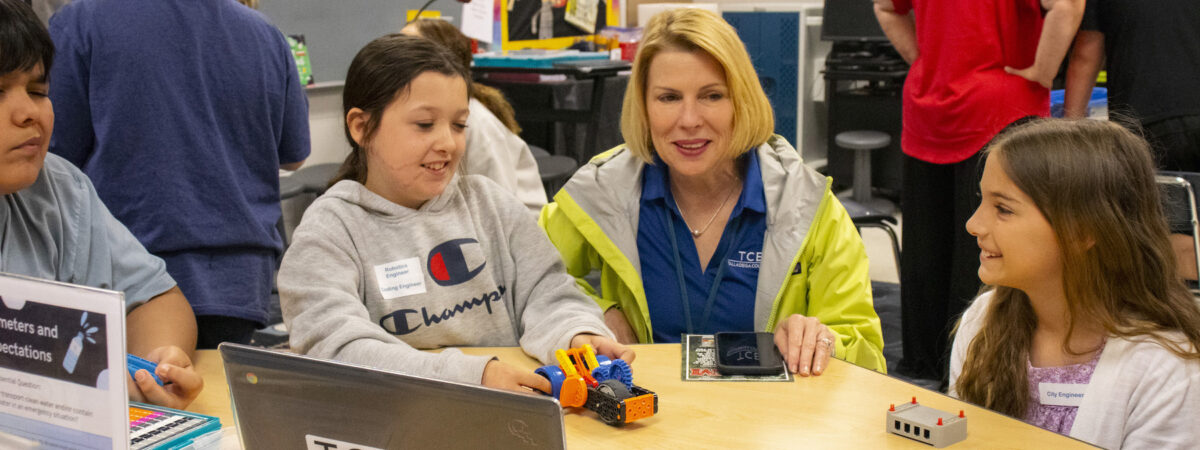
“East-central Alabama’s Talladega County is well-known for the Talladega Superspeedway. Memorialized in the title of Will Ferrell’s hit comedy Talladega Nights, the speedway hosts some of the nation’s most exciting NASCAR events and produces the highest race speeds of any track on the NASCAR circuit. Its pioneering school district, however, has put Talladega County on the map as well.”
Jean-Claude Brizard, “Breaking With the Past: Embracing Digital Transformation in Education”
“This news was devastating; my dream of transforming schools through the integration of technology and Project-Based Learning quickly came to a halt,” Dr. Lacey recalls. During the previous two years, the district’s leaders and community partners had visited successful schools across the country to observe classrooms and see for themselves how technology could impact student learning.
“We visited several innovative school districts across the country. Teams of school and district leaders visited Mooresville Graded School District in North Carolina and New Tech High Schools in California and Ohio,” Dr. Lacey said. “We talked extensively about what we saw and how these successful models might look in Talladega County Schools.”
In order to realize their vision for digital transformation, they would have to lean into new, creative leadership practices including prioritizing innovation, establishing strategic partnerships, and most importantly, leveraging the talent and expertise of the people within their own district.
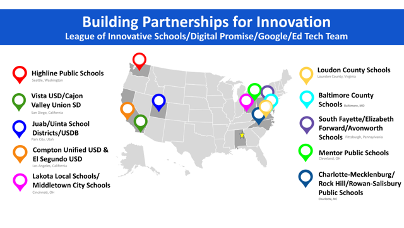
Taken from a presentation Dr. Suzanne Lacey shared during the Spring 2023 League Convening, this map indicates several of the school districts she and her team have had the opportunity to visit and learn from over the past 10 years.
Over the past 15 years, Talladega County Schools has engineered one of the nation’s most remarkable digital transformations of teaching and learning to date.
Several factors compelled the district to assess and change how they were meeting the needs of their students. First, when looking at the demands in workforce development, the district recognized a need for workers who are proficient in applied technology skills as well as soft skills such as team work, problem solving, punctuality, and communication. Moreover, with so many technological advancements in not only the world of education, but also the world at large, they knew that they needed to find better ways to engage learners. Given that 93 percent of all STEM jobs have wages above the national average, it was critical to equip their students with the skills and leadership competencies needed to succeed in the future.
“We knew it was vital that we model forward thinking and a growth mindset if we were going to transform teaching and learning in our district,” Dr. Lacey said, “The key to this transformation was empowering school leaders and teachers to try new approaches without fear of failing. Over time, we saw a huge shift in the cultures of our schools. We saw schools redesigning learning spaces, raising expectations of their students, and focusing on sustained professional learning.”
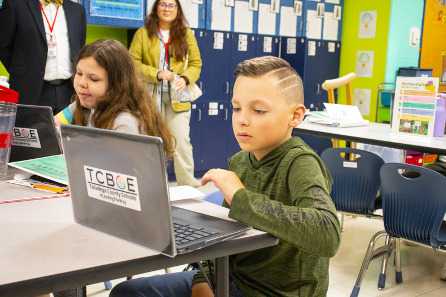
Talladega County Schools is currently implementing a 1:1 digital device to student program, called #LeadingTheWay, which utilizes approximately 6,575 Chromebooks, and 575 iPad tablets, all of which provide 24/7 mobile access to students in grades K-12.
In 2009, TCBOE launched their vision for innovation at a single high school, Winterboro—where graduation rates and disciplinary referrals proved that the current school culture was not meeting students’ needs. The district repurposed maintenance and textbook funds to equip every student with a computer to support their learning—a move that Dr. Lacey recalls feeling “risky.”
Then, they created collaborative learning spaces and budgeted to provide professional learning to develop teachers’ digital skills and help them adopt PBL practices into their classrooms—combining PBL with relevant “real world” experiences to engage students in skills such as communication, creativity, collaboration, and critical thinking. Students no longer sat in rows, but rather in pods and at tables so that they could solve problems together, developing and enhancing skills needed for success for college and careers.
After just a few years, the results were astounding. By 2012, Winterboro’s graduation rate soared to 88 percent. In addition, due to innovative practices and increased engagement of students, disciplinary infractions were cut in half. Based on the success of the Winterboro pilot, Dr. Lacey and the TCBOE team scaled the initiatives district-wide. More than a decade after the Winterboro pilot began, learner-centered pedagogy supported by technology is now the standard across all of the district’s 17 schools.
In 2015, Talladega County Schools joined the Digital Promise League of Innovative Schools, a national network that connects and supports the most forward-thinking leaders in education. The primary purpose of the League is to improve outcomes for students through the powerful use of learning technologies and to support equity in schools. Further, the League partners with entrepreneurs, researchers, and leading education authorities to facilitate new approaches to teaching and learning.
In 2016, the National Science Foundation (NSF) awarded the district with a $300,000 math and science partnership grant. Talladega County Schools used this funding to train leadership cohorts over three years to incorporate STEAM into their classrooms. These leaders in turn supported educators in their buildings.
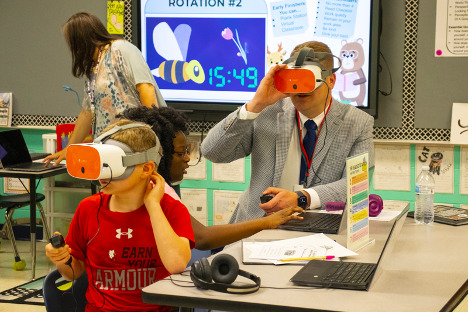
League convenings provide district leaders across the country with opportunities to address shared priorities and challenges, explore emerging technologies, develop action plans, and see powerful learning in action during school visits.
Through their work with the League of Innovative Schools, TCBOE was selected to participate in a research collaborative centered around computational thinking. Along with two other League districts, TCBOE was awarded a $1 million grant to create Computational Thinking Pathways. Over the past four years, TCBOE district has led the nation in this important work. Teacher leaders have developed a pathway for each grade level that includes key standards and computational thinking competencies.
Digital Promise—along with TCBOE, Indian Prairie School District, and Iowa City Community School District—is now engaging six additional districts to design customized, equity-centered pathways. In addition, Digital Promise’s CT Pathways Toolkit is a resource for school districts to guide them in the articulation and design of their own system-wide K-12 learning pathway in computational thinking and computer science.
“This was just the start of many innovative initiatives directly influenced by the League of Innovative Schools,” Dr. Lacey said. Another were the biannual League of Innovative Schools convenings co-hosted by Digital Promise and League member districts—opportunities for district leaders to come together to address shared priorities and challenges, explore emerging technologies, develop action plans, and see powerful learning in action during school visits.
“One of the most beneficial aspects of our League membership was the opportunity to visit innovative school districts across the country,” Dr. Lacey said. “Seeing is believing. The information that we gathered from these school visits helped us to further expand our vision for innovative learning.”
More recently, the district joined a cohort facilitated by the Center for Inclusive Innovation to develop an inclusive cybersecurity pathway for students, specifically designed to support students who have been historically underrepresented in the field.

A key component of the district’s STEAM work is the Engineering Design Process. Students learn how to research and plan, build a model, test it, reflect on the results, and determine what is needed to improve the process.
Just last month, it was TCBOE’s turn to host the League. District leaders from more than 140 school districts, League supporters and partners, and Digital Promise staff traveled to Alabama for the Spring 2023 League Convening, hosted by Dr. Lacey and her team at Talladega County Schools. During school visits, participants saw for themselves the opportunities that the district has created at their Lincoln and Munford campuses to enable students and educators to innovate daily.
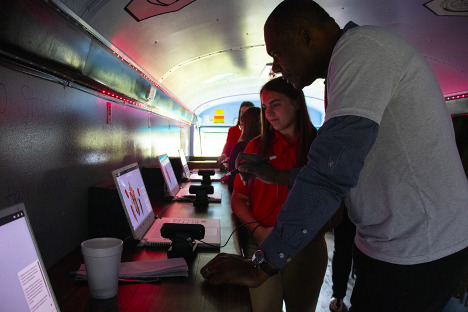
Inside of ZIP, an old bus that has been revamped and outfitted as a mobile virtual lab, a Munford student explains how students can virtually dissect organs using zSpace virtual reality content.
For example, they recently converted an old school bus into a mobile virtual lab with zSpace virtual reality content. The building construction class removed all of the seats, added the necessary wiring, and built a wheelchair lift to provide accessibility. “ZIP” travels to each school, and students can virtually dissect organs, study weather patterns, and design house plans.
“This resource is especially beneficial for our career tech program. Students can have experiences in welding, automotive repair, industrial robotics, electronics, and HVAC fundamentals,” Dr. Lacey shared.
“WALI” (Whole Child Approach to Learning with Innovative Sensory), another traveling bus, is a sensory resource designed for students with varying needs, such students with autism or other exceptionalities who need a quiet, safe, and interactive space to learn and to relax.
Not only that, TCBOE’s Munford schools have access to extensive outdoor classrooms including an amphitheater, nature trail, longleaf pine stand, low ropes course, greenhouse, fish pond, frog pond, five-tier wetland, butterfly gardens, bluebird trail, and even an aquaculture facility. By combining PBL and STEAM, the district provides students with powerful learning experiences situated in real-world challenges. This has earned Talladega County Schools the designation of a U.S. Department of Education Green Ribbon School System, and several of their schools were selected as U.S. Department of Education Green Ribbon Schools.
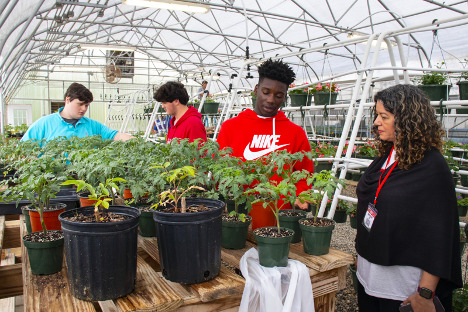
District-wide, the current graduation rate of 97 percent is reflective of just how far the district has progressed during its digital transformation, up from 79% when the journey began. In addition, 86 percent of TCBOE’s high school graduates are considered college and career ready based on criteria set by the state of Alabama.
Beyond these innovative approaches to teaching and learning, it is evident how Talladega County Schools has intentionally created authentic opportunities in career technical pathways to meet the demands of both the local and regional job market. Students can now earn credentials in fields such as computer science, engineering, and building construction to increase their marketability upon graduation from high school.
A program that Dr. Lacey is particularly fond of is the Tiny House program, based at Lincoln High School. Students build a tiny house from the ground up and use the proceeds from selling the house to invest in building new ones. This video showcases how the district engages students in authentic learning opportunities to help prepare them for the workforce.
In each of these examples, edtech is not the solitary solution, but rather enables powerful pedagogy delivered by teachers who have received the support and professional development needed to harness that technology. Talladega County Schools is truly an exemplar of how technologies applied skillfully—with an understanding of what students need and want—can lead to educational frameworks that are learner-centered, personalized, effective, and transformative.
Want to know more about Talladega County Schools’s innovative approaches and digital transformation? Find more resources here:

We want to hear from you!
Please take this 5-minute survey and help us serve you better.
